Introduction
The Maestrazgo UNESCO Global Geopark has its roots in the Maestrazgo Cultural Park which is made up of 43 municipalities (Fig. 1), located in the province of Teruel (Autonomous Community of Aragon, Spain). It has an area of 2,622 km2 and stands out for its sparse population (some 5.5 inhabitants per square kilometer on average) and its rich and varied geological and paleontological heritage due to a very complete sedimentary record of the last 200 million years of Earth history. This territory was ground-breaking for both geoparks and dinosaurs: in 2000 it was one of the four territories that founded the European Geoparks Network (Zouros & McKeever 2009), and the first new dinosaur in Spain was described in this territory. In this contribution we present the most relevant dinosaur milestones related to the Geopark, while details about it can be found in Simón et al. (2011), Alcalá (2017, 2018), Alcalá et al. (2015) and Mampel & Hernández (2016), among others.
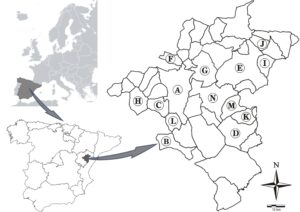
Figure 1. Locality map of Maestrazgo UNESCO Global Geopark. Code for municipalities mentioned in the text: A) Aliaga; B) Allepuz; C) Camarillas; D) Cantavieja; E) Castellote; F) Castel de Cabra; G) Ejulve; H) Galve; I) Las Parras de Castellote; J) Mas de las Matas; K) Mirambel; L) Miravete de la Sierra; M) Tronchón; N) Villarluengo.
The Geopark contains many extensive outcrops of continental facies ranging in age from Late Jurassic to Early Cretaceous. This, together with a noticeable relief and sparsevegetation, has led to the discovery of dinosaurremains in severalmunicipalities: Aliaga, Allepuz, Camarillas, Cantavieja, Castellote, Castel de Cabra, Ejulve, Galve, Las Parras de Castellote, Mas de las Matas, Mirambel, Miravete de la Sierra, Tronchón and Villarluengo (Lapparentet al. 1969; Sanz et al. 1987; Canudo et al. 1996, 2005; Ruiz-Omeñacaet al. 2004; Infante et al. 2005; Luque et al. 2006-2007; Sánchez-Hernández et al. 2007; Alcalá et al. 2009; Cobos 2011; Royo-Torres et al. 2014; Gasca et al. 2015; Rey et al. 2018, etc.). The ever-increasing scientific findings associated with these discoveries illustrate the clear potential of this area for dinosaur study (Fig. 2). This contribution focuses on the most relevant fossils and their use (for their scientific, historical, educational or touristic value) in the promotion of geotourism in the Geopark. The chronostratigraphy of the sites with dinosaurs ranges from Kimmeridgian to Maastrichtian, with particular abundance from Tithonian to Barremian, spanning a number of geological formations that vary regionally (Díaz-Molina & Yébenes 1987; Ruiz-Omeñaca et al. 2004; Sánchez-Hernández et al. 2007; Royo-Torres et al. 2014; Aurell et al. 2019; Campos-Soto et al. 2019).
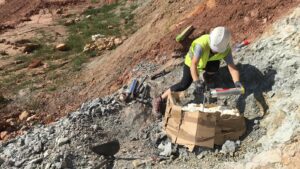
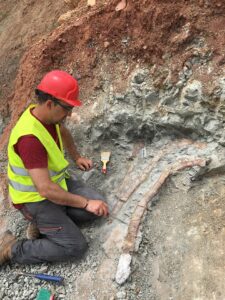
Figure 2. Dinosaur finds in the Geopark have been continuously produced for decades: left, recovery of ornithopod vertebrae, and right, the unearthing of ornithopod ribs, in an excavation carried out by the Dinópolis Foundation in Galve on June-July, 2020.
The first Spanish dinosaur
Although the first references of dinosaurs in Spain date back to the 19th century (Vilanova 1872, 1873), it was not until the end of the last century that the first new dinosaur taxon was described, and it came from a municipality in the Maestrazgo Geopark. In 1934, the construction of the old road to Galve led to the discovery of Las Zabacheras, the type locality of Aragosaurus (Fernández-Galiano 1958, 1960; Sanz et al. 1987; Royo-Torres et al. 2014). In 1958 a resident of the village, Mr. José María Herrero (1925–2012), reported his collection of dinosaur bones from Galve. At the same time, Albert F. de Lapparent (1905–1975), from the Institut Catholique de Paris, was the first paleontologist to suggest that some of the recovered fossils belonged to a new sauropod taxon related to camarasaurs (Lapparent 1960). Subsequently, in 1982 a team of paleontologists made up of researchers from the Universidad Autónoma de Madrid and the Instituto de Paleontología de Sabadell (today the Institut Català de Paleontologia) excavated the type locality and the resulting research enabled the first dinosaur from Spain to be named: Aragosaurus ischiaticus (Sanz et al. 1987). The name refers to the Autonomous Community where Galve is located (Aragon) and to the large pubic peduncle of the ischium (Fig. 3). Despite being the first Spanish dinosaur, it had no impact on subsequent studies of sauropods. In 2014, work was carried out to complete the skeleton record (developing a new excavation at the type site) and update its dating and classification in light of the great progress since made in the stratigraphy of the area and in sauropod systematics. This medium-sized sauropod was thus adjudged to correspond to a basal macronarian that did not belong to the Titanosauriformes clade (D’Emic 2012; Royo-Torres et al. 2014). Likewise, new chronostratigraphic data place the type locality of Aragosaurus in the Villar del Arzobispo Formation, which includes the Jurassic–Cretaceous transition; the site is likely to be Berriasian in age, a little less than 145 million years old (Santos et al. 2018; Aurell et al. 2019; Delvene et al. 2019; Campos-Soto et al. 2019).
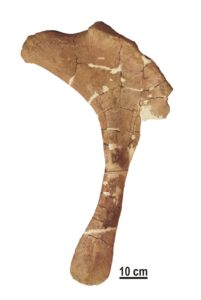
Figure 3. The most peculiar bone of Aragosaurus ichiaticus, the ischium.
To combine research results with scientific dissemination, which is one of the main goals of the Dinópolis paleontological network from the Aragon Government (Alcalá 2018), the new Aragosaurus fossils were temporarily put on public display, immediately after their publication, in a special display case in the Dinosaurs Hall of Dinópolis.
From the Late Jurassic of Galve (Kimmeridgian–early Tithonian) the remains of an incomplete individual of another new sauropod were defined with the name of Galveosaurus herreroi (Sánchez-Hernández 2005; Galvesaurus herreroi according to Barco et al. 2005). Its most recent cladistic analyses indicate that it is a brachiosaurid titanosauriform (Pérez-Pueyo et al. 2019).
An Iguanodon Living and Breeding Area
The Iguanodon found in Galve shares a story similar to that of Aragosaurus, but in this case from the Lower Cretaceous Camarillas Formation of the La Maca site. The first remains of this genus were also recognized by Lapparent and those same fossils were later described as belonging to a new genus and species, Delapparentia turolensis, by Ruiz-Omeñaca (2011). However, a detailed study of the intraspecific variability of Iguanodon found that all the characters regarded as diagnostic for this taxon fall within the range of variation found in Iguanodon bernissartensis (Verdú et al. 2017), so they consider the holotype of Delapparentia as belonging to an indeterminate species of Iguanodon. Besides, new fossils of another iguanodontian from Galve have been described as a new species, Iguanodon galvensis (characterized by: a prominent tuberosity on the articular surface of the iliac peduncle of the ischium; moderately compressed middle-to posterior dorsal vertebral centra without a ventral keel; and a rugose and inflated ridge on the lateral side of the femur shaft near the lateral condyle; Verdúet al.2015, 2018). This new material unveiled a peculiar feature: the discovery of individuals at very different stages of development: embryos, perinates, juveniles and adults. Indeed, the paleontological survey carried out by the Foundation Dinópolis team in a clay quarry starting in 2008 (Verdú et al. 2015; Alcalá et al. 2016) led to the discovery of a group of thirteen specimens of Iguanodon babies (Fig. 4). Histological and osteological features indicate that they are early nestlings in their first year of life; they probably belong to the same breeding season and could even be part of the same clutch. Their association with embryonic specimens reveals that this nestling-group remained close to the nest for a time, suggesting some kind of “nursery” behavior, and an adult might have provided some kind of parental care (Verdú et al. 2015).
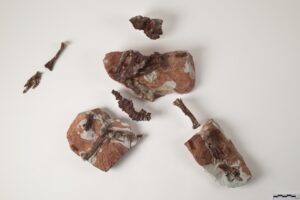
Figure 4. Skeleton of an Iguanodon perinate from the Galve “nursery”.
Other iguanodontian remains found in the Aliaga Geological Park (Las Dehesillas site) are also attributed to Iguanodon galvensis. They consist of a partially articulated specimen of a 9–10-m-long ornithopod, of advanced age, found in the lower Barremian outcrops of the Camarillas Formation. The material comprises a cervical vertebra and ten dorsal vertebrae, several ribs, and some ossified tendons. The phylogenetic analysis indicates that it is closely related with the contemporary and sympatric species Iguanodon galvensis rather than with the type species of the genus, Iguanodon bernissartensis (Verdú et al. 2021). For this reason, it was assigned to Iguanodon cf. galvensis.
Iguanodontian fossils are abundant in many outcrops of the Lower Cretaceous of the Geopark, for example: in Miravete (upper Hauterivian–lower Barremian alluvial and fluvial facies in the El Castellar Formation, Luqueet al. 2006-2007), Castellote (Ladruñán) and Tronchón (lower Barremian-basal upper Barremian, Mirambel Formation, Gascaet al. 2015). Their range may have reached the Albian (Escucha Formation) where iguanodontians probably related to Proa valdearinnoensis were documented in Castel de Cabra (Rey et al. 2018).
Other remarkable dinosaurs in the Geopark
The species Gideonmantellia amosanjuanae comes from the Early Cretaceous of Galve (Fig. 5), a small basal ornithopod described from the partial skeleton of a juvenile individual approximately 1 m long (Ruiz-Omeñaca et al. 2012).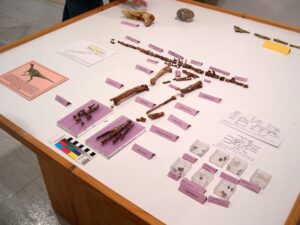
Figure 5. Partial skeleton of Gideonmantellia from the municipal exhibition in Galve.
Although theropod dinosaur remains are generally scarce, the discovery of several associated bones in the Barremian of Camarillas led to the description of a new genus and species of theropod, Camarillasaurus cirugedae, by Sánchez-Hernández & Benton (2014). These authors initially classified it as a ceratosaur placed near the base of the clade, but it was recently reinterpreted as belonging to a megalosauroid tentatively related to spinosaurids (Rauhut et al. 2019; Malafaia et al. 2020).
The continental Early Cretaceous of Allepuz, Ejulve, Mirambel and Villarluengo (where a vertebra from the Barremianis is similar to the caudal ones of the sauropod Tastavinsaurus), among other localities, has provided isolated dinosaur remains. Some have been known for decades while others have been found recently. This confirms the potential of the Geopark outcrops to provide new dinosaur discoveries.
This summary of the Geopark dinosaur record should be completed with a fossil found in the Maastrichtian sediments of Cirugeda (Aliaga). It consists of an isolated fragment of a dorsal neural arch. It was attributed to a titanosaur sauropod (Canudo et al. 2005) of similar size and characteristics to Lirainosaurus. This represents the only direct dinosaur remains dated as Late Cretaceous documented to date in the province of Teruel.
Facilities available to visitors
The long recorded paleontological tradition in Galve (where, in addition to dinosaurs, new types of invertebrates, amphibians, mammals, turtles, and crocodilians have been found) was awarded the status of a “satellite” Dinópolis center (a public network of paleontological facilities) in 2003 (Fig. 6). Some original fossils of Aragosaurus and Iguanodon are exhibited there, as well as replicas of fossils found in the municipality and on similar sites from the Isle of Wight (from the Dinosaur Isle Museum in Sandown, UK). A life-sized reconstruction of four Aragosaurus dominates the exhibition area, which includes a small paleontological laboratory and explanations about the laboratory techniques used to prepare dinosaur fossils before they are studied.

Figure 6. Member of the staff of the Tumbler Ridge UNESCO Global Geopark in front of the Dinópolis satellite center in Galve.
Fossils of Aragosaurus are also displayed in Galve, in a local exhibition under municipal management (consisting of dinosaur bones from a private collection and the Provincial Museum of Teruel). In addition, another type of material is also on display: holotypes of the sauropod Galveosaurus and the ornithopod Gideonmantellia. Finally, since 1993 the vicinity of the town features some open air, life-sized, dinosaur reconstructions (Fig. 7).
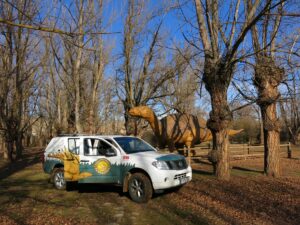
Figure 7. “Cretaceous Park” in Galve.
The town of Castellote is another destination of interest to explore the dinosaurs of the Geopark with its Dinópolis facility which opened in 2006. Although its main focus is on paleobotany, it also refers to the dinosaurs that were found there (Lapparent et al. 1969), and later deposited in the National Museum of Natural History in Paris. Among them were Iguanodon remains. The installation offers different interpretations of their anatomy (Fig. 8). These range from the time of Gideon Mantell, reconstructed with a few bones, to the reconstruction under Richard Owen's direction for the Great Exhibition of London in 1851, and finally to the current consensus based on numerous complete skeletons and tracks.
In terms of paleontology dissemination, the Dinópolis facilities are the most visited and most important elements of the Geopark, and also of the province. This is due to the importance given to the project by the Government of Aragon. In the provincial headquarters in the city of Teruel, one can enjoy the exhibition of an outstanding fossil of the Geopark: the original partial skeleton of Iguanodon found in Aliaga (Fig. 9).
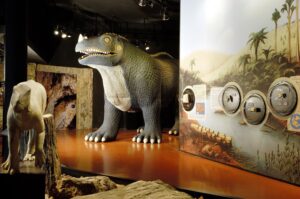
Figure 8. Iguanodon exhibition area in the Dinópolis satellite of Castellote.
The local paleogeographic changes recorded from the marine Jurassic, its continental transition to the Cretaceous, the marine Aptian and its passage to the continental Albian are represented in the exhibition “Water, Time and Earth” of Mas de las Matas, a town very close to Castellote. These four episodes are illustrated with original fossils from the area and with various audiovisual resources.
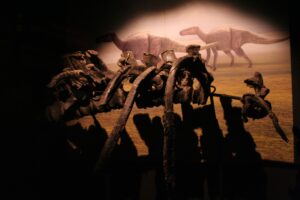
Figure 9. Iguanodon from Aliaga in Dinópolis-Teruel headquarters.
There are two further Geopark visitor centers: the Aliaga Geological Park Visitor Center, which presents a replica of Iguanodon bones as they were found in the site (Fig. 10), and the Maestrazgo Cultural Park Visitors’ Center in Ejulve, which mentions the details of the dinosaur remains in the Geopark.
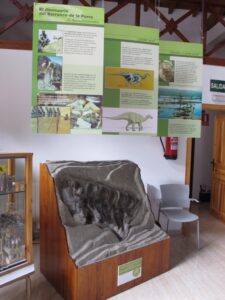
Figure 10. Iguanodon area in the Aliaga Geological Park Visitor Center.
Geoconservation
Concerning the conservation of dinosaur bones, the moveable nature of this public heritage means that its effective protection is not carried out in situ but rather in institutions such as museums. However, there are legal provisions that guide the preventive conservation of paleontological sites so that the fossils they contain are not damaged by public works or removed by people with private interests. Dinosaur bone sites are covered by a range of legal regulations. As they are included in the territory of a UNESCO Global Geopark, they form part of a protected area following Spanish Law 42/2007, of December 13, on Natural Heritage and Biodiversity. Likewise, as paleontological sites, the activities that can be carried out in them are regulated by the Aragonese Law 3/1999, of March 10, of the Aragonese Cultural Heritage, in which Title III specifically treats paleontological and archeological heritage. In this regard, there is an organization of the Spanish Civil Guard, SEPRONA (Servicio de Protección de la Naturaleza, Nature Protection Service) that monitors the main paleontological sites; to better achieve their objectives, training sessions for SEPRONA officers are given by the director of the Dinópolis Foundation, Ph.D. in paleontology. Furthermore, the Las Dehesillas site is included in the catalog of LIG (Lugares de Interés Geológico, Sites of Geological Interest of Aragon) as it is part of the Aliaga Geological Park (LIG number 85 in the Areas of Geological Interest category). Additionally, five dinosaur bone sites are in the list of outstanding geosites of the Geopark: Ladruñán (geosite 29), La Maca-Galve (geosite 31), Ejulve (geosite 33), Las Dehesillas-Aliaga (geosite 40) and Las Zabacheras-Galve (geosite 41). It should be highlighted that conferences, school activities, guided visits, training courses, etc., are scheduled in the Geopark to develop societal knowledge and commitment among the residents concerning the importance of the conservation of their local paleontological resources.
Conclusion
The territory of the Maestrazgo UNESCO Global Geopark contains a great wealth of sites that have yielded remains of dinosaurs, especially from the Late Jurassic and Early Cretaceous. This allows paleontologists to decipher their characteristics and their evolution in the south-western European context. So far, six new genera and seven species have been documented and defined (including the first dinosaur from Spain), including sauropods, ornithopods and theropods. All this confers a unique value to the body of geological and paleontological research developed in the Maestrazgo Geopark, which is now being leveraged to promote education and geotourism through visitor centers and Dinópolis satellite facilities.
Acknowledgments
The authors acknowledge Prof. Dan Grigorescu’s gracious invitation to participate in this special issue. Departamento de Educación, Cultura y Deporte (Gobierno de Aragón), Research Group E04_20R FOCONTUR financed by Departamento de Ciencia, Universidad y Sociedad del Conocimiento (Gobierno de Aragón) and FEDER funds ´Construyendo Europa desde Aragón´, Instituto Aragonés de Fomento (IAF), Dinópolis. Research project PGC2018-094034-B-C22 (MCIU/AEI/FEDER, UE), and Unidad de Paleontología de Dinosaurios de Teruel (Ministerio de Ciencia e Innovación). We acknowledge the helpful suggestions made by Mohamed Abioui and an anonymous reviewer.
Conflict of interest
The authors declare that they have no conflicts of interest.
